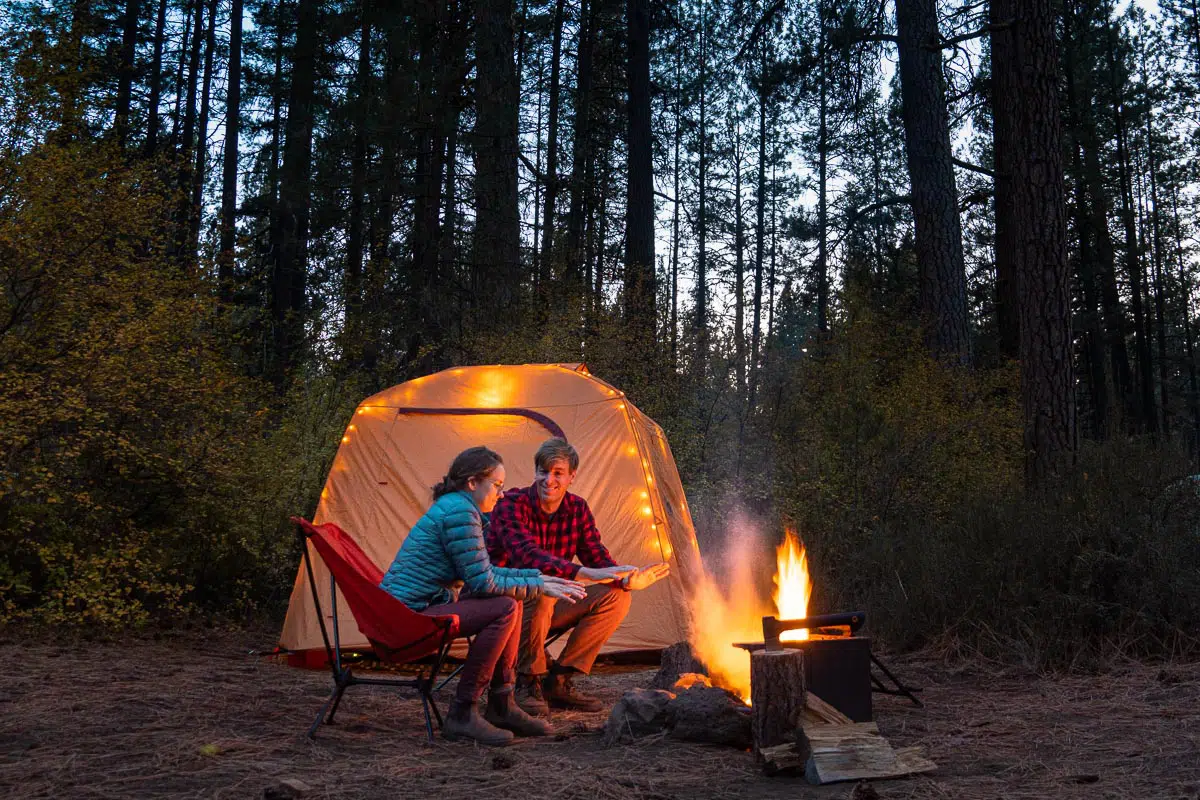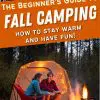Everything You Need to Know About Fall Camping
This post may contain affiliate links.
Camping in the fall is a great way to extend your camping season, enjoy the outdoors with fewer crowds (and fewer bugs!), and surround yourself with beautiful autumn colors.
In this post, we’ll help you plan your fall camping trip, cover the gear and clothes you need to stay warm, and share our favorite tips for a fun and cozy experience!
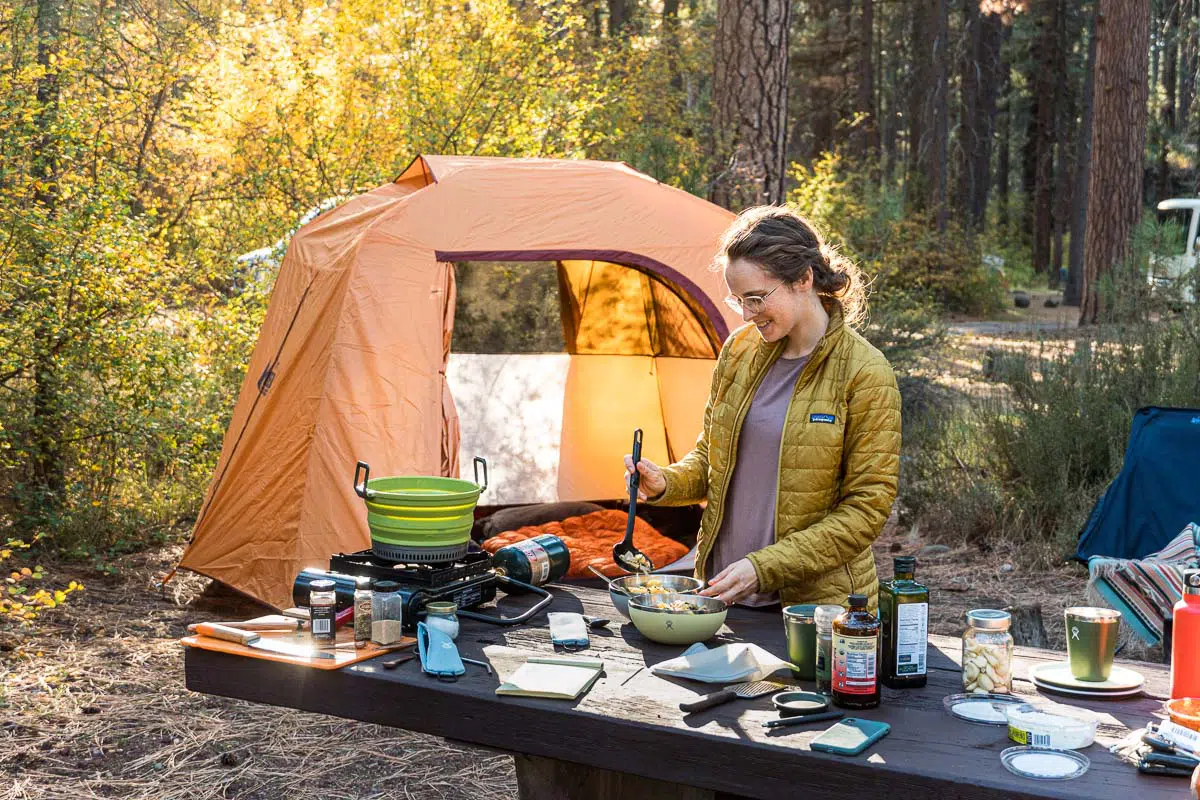
Fall is our favorite time of year to go camping. Campgrounds are far less crowded after Labor Day, the temperatures are pleasant during the day and cool at night, and bugs have all disappeared! Besides, autumn is such a wonderful season to be outdoors.
After a hot and sticky summer, the cool air of fall can feel like an absolute relief. It actually feels good to be outside again. Now going on a hike doesn’t need to be a complete sweatfest and making a warm campfire actually sounds cozy.
There’s a lot to see on a fall camping trip too! Fall foliage is one of the most spectacular displays in the natural world. Leaves bursting into reds, oranges, and yellows. And going on a camping trip is one of the best ways to experience the event firsthand. Stay out to watch the sunset filter through the leaves, or wake up early to catch the first glow of morning light up the forest. It can be magical.
While there is a lot to get excited about when it comes to fall camping, there are also a few unique challenges you may not face during the summer. The potential for inclement weather, staying warm, and shorter daylight hours are just a few things you will want to think about ahead of time.
But don’t worry, we cover everything you need to know below. By the end of this article, you’ll be ready to get out there and have a fantastic fall camping trip!
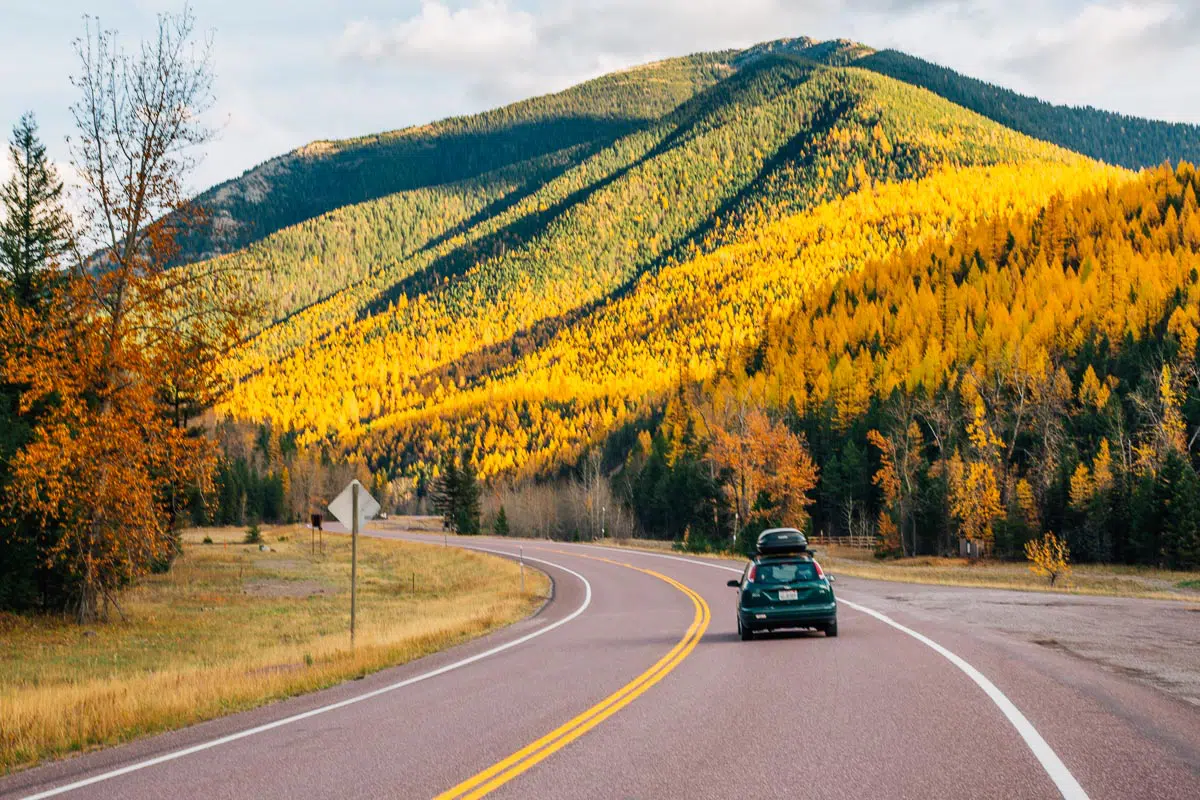
Planning your fall camping trip
Fall Foliage Map: If you are looking to catch the fall foliage season, the best place to start is the Smoky Mountains Fall Foliage Map (it covers the whole US—not just the Smokys!). This is an interactive, predictive map that is updated each year based on the weather conditions experienced during the spring and summer months. And should give you a good sense of when your region will be in full colors.
Check With Local Ranger Stations: Ranger stations can be a wealth of local, non-internet-searchable information. Current foliage conditions, nearby hikes with the best colors, and even best campgrounds. You will have to call and speak with somebody, but you’ll be able to get a lot of nuanced information about the area.
Look up where you are interested in camping and check which ranger station it is covered under. Note: most ranger stations have limited daytime calling hours.
Try out a campervan or RV! With cooler temps and shifting weather, fall is a really great time to try out a van or RV, which will give you a little extra protection and comfort. There are lots of rental marketplaces to choose from–check out Outdoorsy or Escape Campervans (they have some really great Weekend deals!).
Make a Campsite Reservation: One of the big perks of fall camping is the ability to make a reservation on somewhat short notice. Throughout the summer, most campgrounds are completely booked out for weeks, but after Labor Day you’ll have a chance to snag some open spots a few weeks or even a few days in advance.
Even if spots look to be open, we still recommend making a reservation in advance if possible. The peace of mind knowing you have a site is worth it!
Generally speaking, there are two websites that will allow you to make camping reservations, Reserve America and Recreation.gov. Some state parks have their own reservation systems, and you’ll have to book directly for most private RV parks.
- Scope out your site: We use the website Campsite Photos to help us see what a particular campsite will look before we commit to making a reservation. This way we can try to select a campsite that has some deciduous trees nearby (that might have color).
Double-check campgrounds are open: If you aren’t able to make a reservation, at least double-check the campground is open. Many campgrounds will start to scale down and possibly close starting as early as Labor Day. Some closure dates might be posted online ahead of time and some might be weather dependent, so be sure to check in advance.
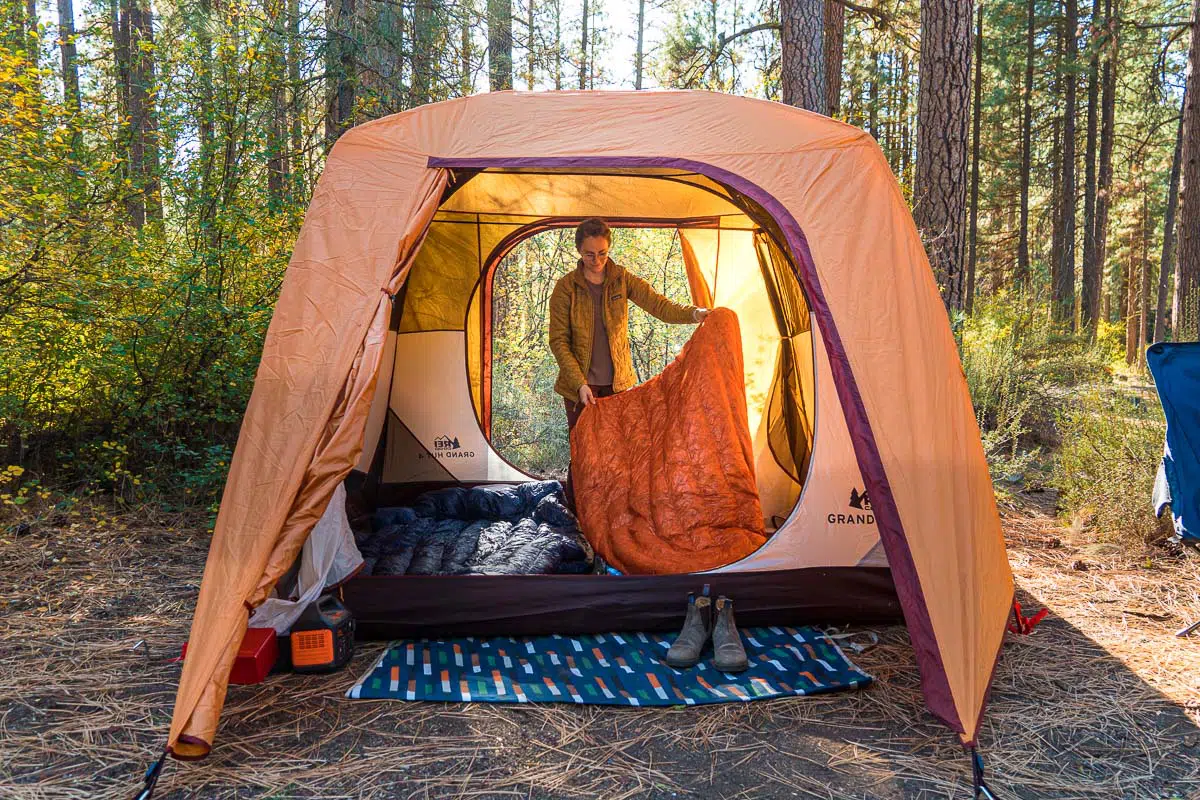
Fall camping gear checklist
You will need much of the same camping gear as you did in the summer, however, there are a few items that are particularly important for camping during the fall. Below are some of what we would consider must-have fall camping gear essentials:
✔︎ Tent: with interior space & waterproof rainfly (such as the Eureka Space Camp). You’ll be grateful for the extra space if you’re stuck inside due to rain, or want to hang out after dark. Make sure you pick up a tent footprint or groundsheet if it’s not included.
✔︎ Sleeping Bag: choose one that is rated at least 10ºF below the nighttime low you expect (or 15º-20ºF below if you’re an especially cold sleeper). Here are some top-rated cool weather sleeping bags. Pro Trip: A sleeping bag liner can help add a few degrees of extra warmth to your sleeping bag.
✔︎ Insulated Sleeping Pad: We recommend a pad with at least a rating of R-4 in the fall (but higher the better!). This is a good budget-friendly R-5 pad, this is our favorite pad for true comfort, and this is a great 2-person camping mattress. Pro tip: To increase the R-value of your sleeping pad, you can add a foam pad underneath.
✔︎ Tarp & guylines or rain shelter
✔︎ Camp Chair: A chair with a little foam padding like this one will offer a little more warmth.
✔︎ Extra blankets: check out this cozy flannel & fleece blanket, this insulated puffy blanket, or this blanket that turns into a poncho!
✔︎ Camp stove with decent wind protection, as well as your camping cookware and dishes.
✔︎ Hatchet and fire starting material: If there isn’t a fire ban, fall is the perfect time to cozy up next to a campfire!
✔︎ Sit pads or cushions to put on picnic benches for warmth during meals.
✔︎ Headlamps or a lantern: with shorter days, you’ll need a way to get around camp after the sun goes down.
✔︎ String Lights are another form of portable, rechargeable illumination. Nothing turns a tent into a cozy abode like a set of twinkle lights.
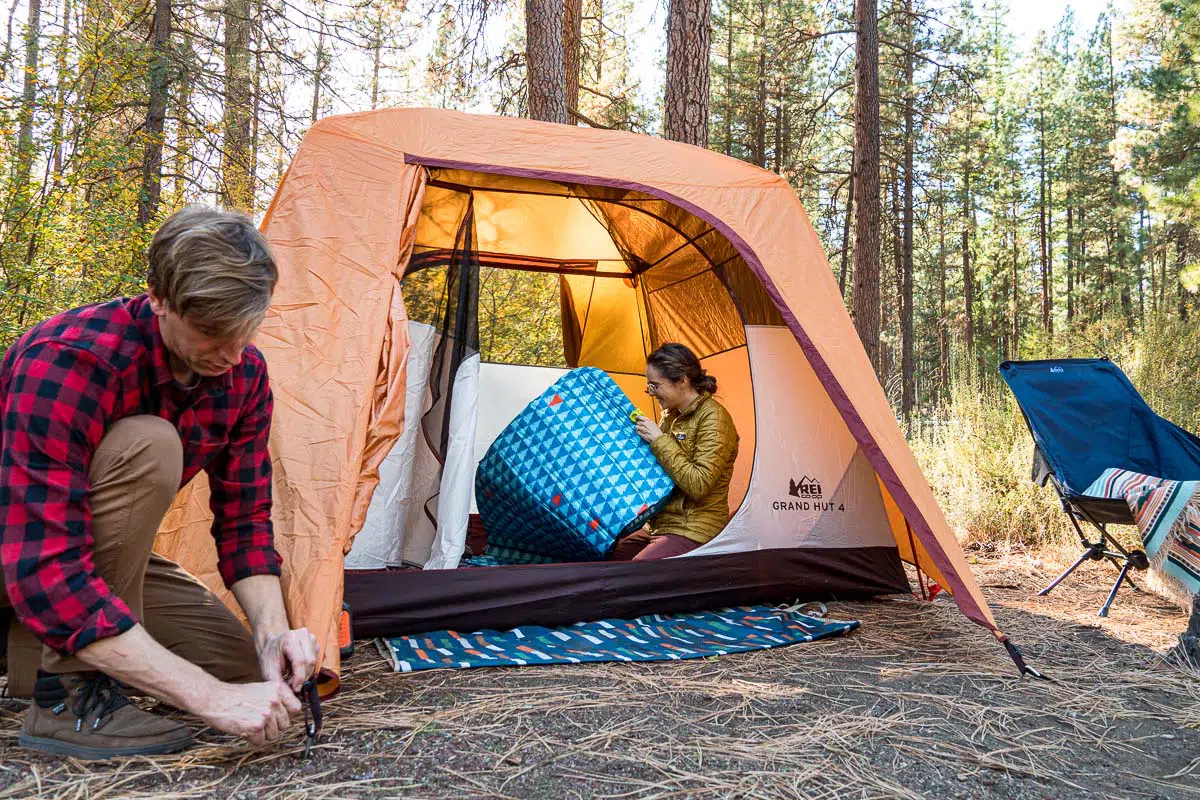
Setting up camp
In the summer, it doesn’t matter as much how you set up your camp, but in the fall you will want to be a little more intentional about a few things:
- Plan on getting to camp with enough daylight to set up (remember, the days are getting shorter!) Nobody wants to be setting up camp in the dark.
- If wind is a concern, pick a sheltered spot behind trees, bushes, boulders, or even your car.
- If available, choose a spot on higher ground—cold air will sink into depressed spots on the ground, and rain is more likely to pool there, too.
- Set up a tarp over your picnic table if there’s any chance of rain so you have a dry place to cook meals. A tarp can also be used to block wind.
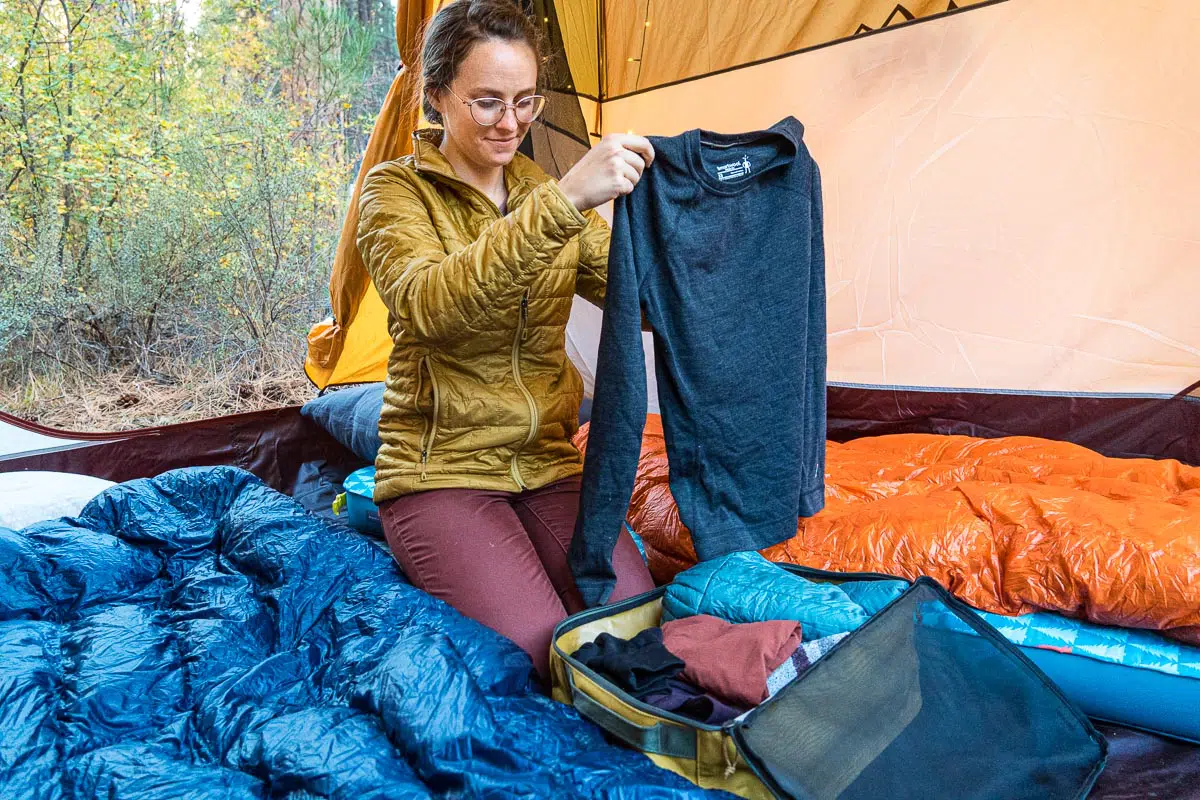
Clothing for camping in the fall
Even if it feels perfectly pleasant during the day, you should be prepared for temperatures to dip during the night. When it comes to packing clothes for a fall camping trip, be prepared for it to get chilly. You can always take off a layer, but you can’t put another layer on if you didn’t bring one!
Layering basics
• Start with a base layer, which will help wick moisture away from your body. This layer should be made of wool or a synthetic material—not cotton! Smartwool is a great brand that makes warm base layer tops and leggings.
• Next up is your mid layer, which could be a fleece sweater or a lightly insulated jacket if it’s on the colder side. Patagonia’s Better Sweater and the Re-Tool Pullover are great choices.
• When the temperature really drops, it’s time to add on your insulating layer. A puffy jacket like REI’s 650 Down Jacket is perfect for this task! We also love Patagonia’s Down Sweater, or the Nano Puff if it’s not going to be super cold out.
• Finally, you’ll want a wind and waterproof outer shell layer. This layer does two things: trap heat, and keep warmth-zapping elements like wind and water out. The REI Rainier jacket is a great choice.
Additional clothing for fall camping
- Rain gear: in addition to a waterproof jacket, it might be wise to pack a pair of rain pants.
- Warm socks: Wool socks are perfect for fall camping! Just be sure that they aren’t too bulky inside your shoes—if your footwear fits too snug, it can reduce your circulation and cause cold feet.
- Warm boots/shoes: Waterproof boots or shoes are best if you expect any rain, and they can also keep your feet a bit warmer.
- Warm hat/beanie
- Buff, gaiter, or scarf
- Mittens or gloves
- Cozy pajamas
- Extras of everything! In the event that something gets wet, you’ll want backups of critical items like socks, shoes, a hat, and warm layers.
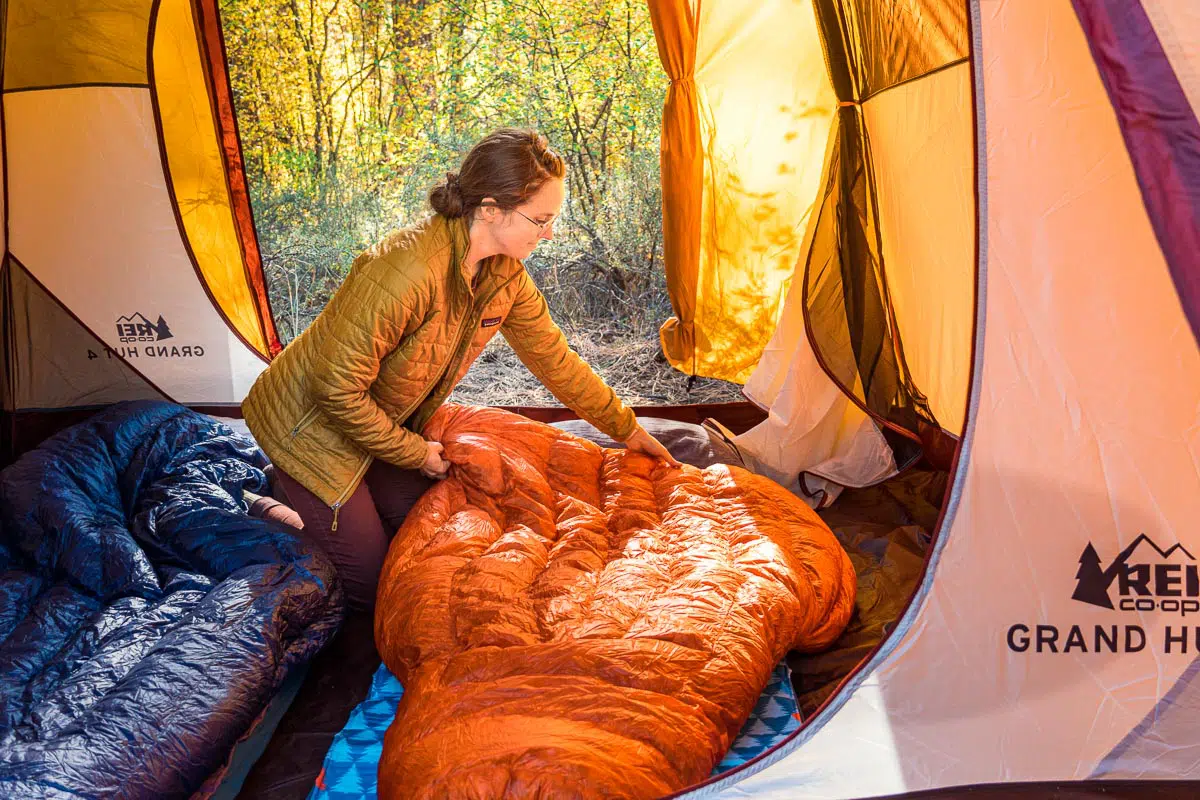
Staying warm while camping in fall
How do I stay warm? It’s one of the biggest questions that people have when thinking about camping in the fall! Here are our best tips for keeping warm while camping in cooler temperatures.
- Layer up!
- Keep moving throughout the day. Plan fun activities that will keep your body temperature up, like hiking or bike riding (keep reading below for more ideas!).
- Go to bed warm. Before getting into bed, move around a bit. Do jumping jacks to warm up, then crawl right into your sleeping bag.
- Bring a Nalgene filled with hot water to bed. This will help warm your sleeping bag right up (just make sure it’s sealed tight)!
- Put tomorrow’s clothes in your sleeping bag at night so they are warm when you wake up.
- Move around first thing in the morning to get your blood moving and your body warming up. Before you get out your bag, you can try doing a few crunches to warm up. Once you’re out of your tent, a set of jumping jacks will get your heart pumping!
- When nature calls, don’t ignore it—especially at night. Your body will naturally try to keep your core (including your bladder) at 98.6F, which means that it will direct less heat to your limbs. By using the bathroom right away, you’ll stay warmer.
- Hand & foot warmers can be really helpful, especially in the early mornings. You can stash a few Hot Hands in your camping box, or invest in a rechargeable hand warmer.
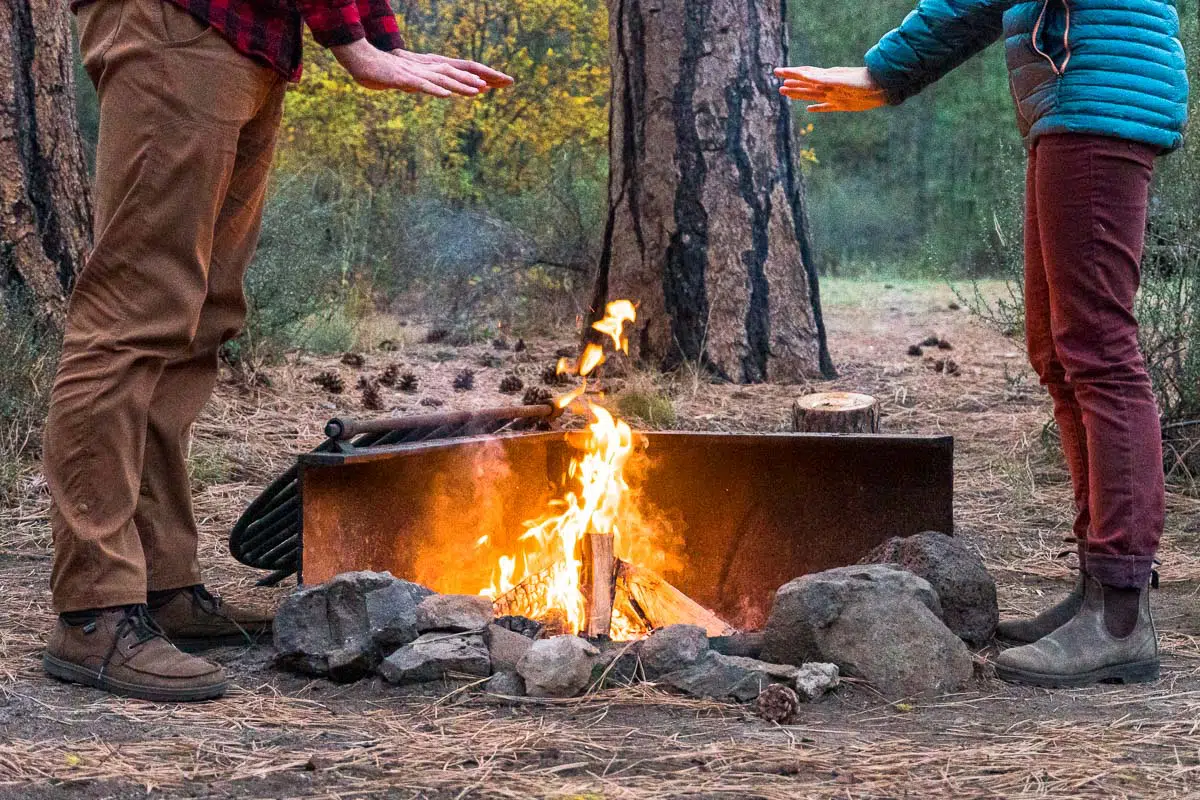
Campfire safety & tips
Fall is the perfect time for a cozy campfire. But before you get started, it’s important to quickly familiarize yourself with a few campfire best practices.
- Check local regulations and make sure fires are allowed in your area. Some fire bans from summer can extend into the fall. If open fires aren’t allowed but propane fires with an on/off switch are, consider bringing a propane fire pit.
- Use existing fire rings when they are available. Many established campgrounds will have a metal fire ring. If you are dispersed camping, try to find a fire ring (usually made of stones) that has already been made.
- Build fires 15 feet away from your tent and anything that’s flammable, like bushes and trees.
- When you are done with the campfire (either to go to bed, go for a hike, or leave the campsite) it’s time to extinguish it. Do not leave a campfire unattended. For more information on how to properly extinguish a fire, check out this article.
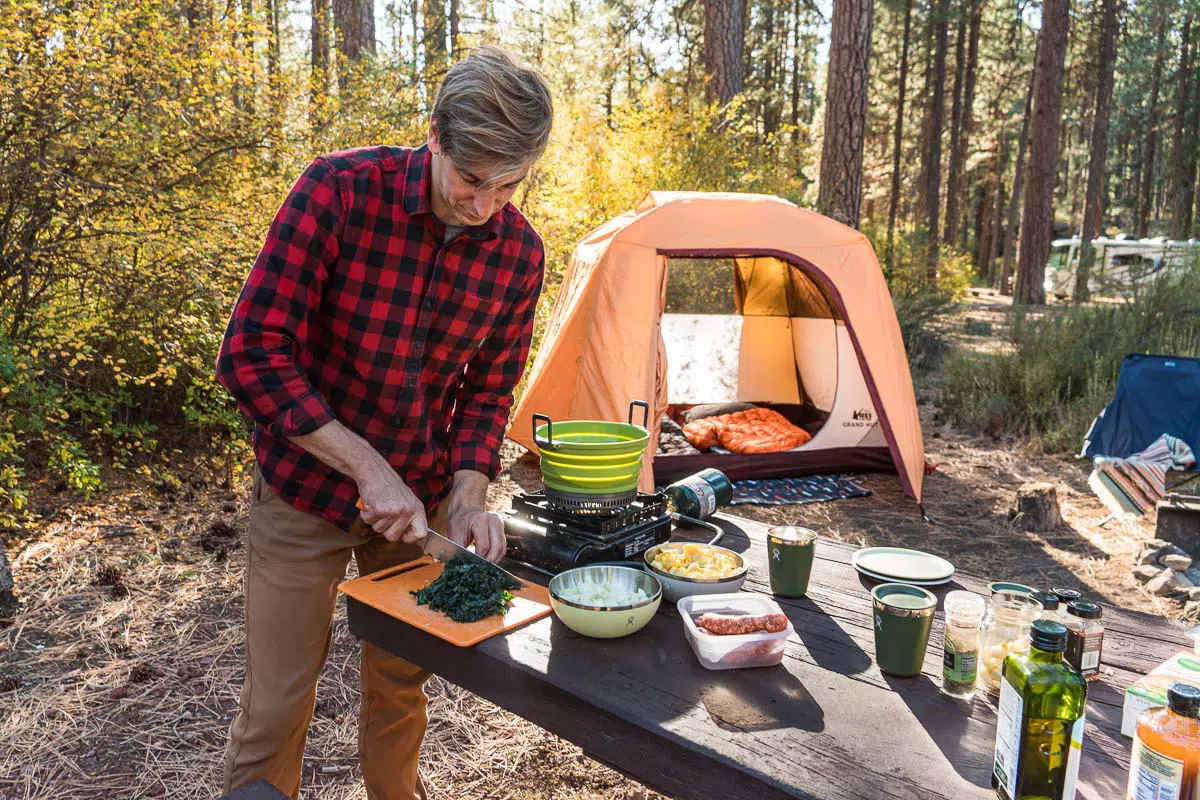
Fall camp cooking tips
When it comes to fall camp cooking, we tend to crave warm, hearty meals. This is also the season where we start to really enjoy cooking over the campfire.
- One pot, Dutch oven, and foil packet meals are great for fall camping. Warm, hearty, comforting food is what we find ourselves craving during the fall, and these types of meals tend to be easier to clean up at the end of the evening!
- Prep what you can at home ahead of time—since the days are shorter you’ll want meals to come together quickly.
- Plan for meals to take a little longer than usual. The cold air and any wind will likely impact your cooking times.
- It’s a good idea to bring a little extra fuel with you. We always find that we use more fuel whenever the weather is cold.
- Doubled walled insulated bottles, mugs, and bowls can make a huge difference when it’s cool outside. Enjoy a hot cup of coffee or steaming bowl of soup for much longer, even when it’s brisk out.
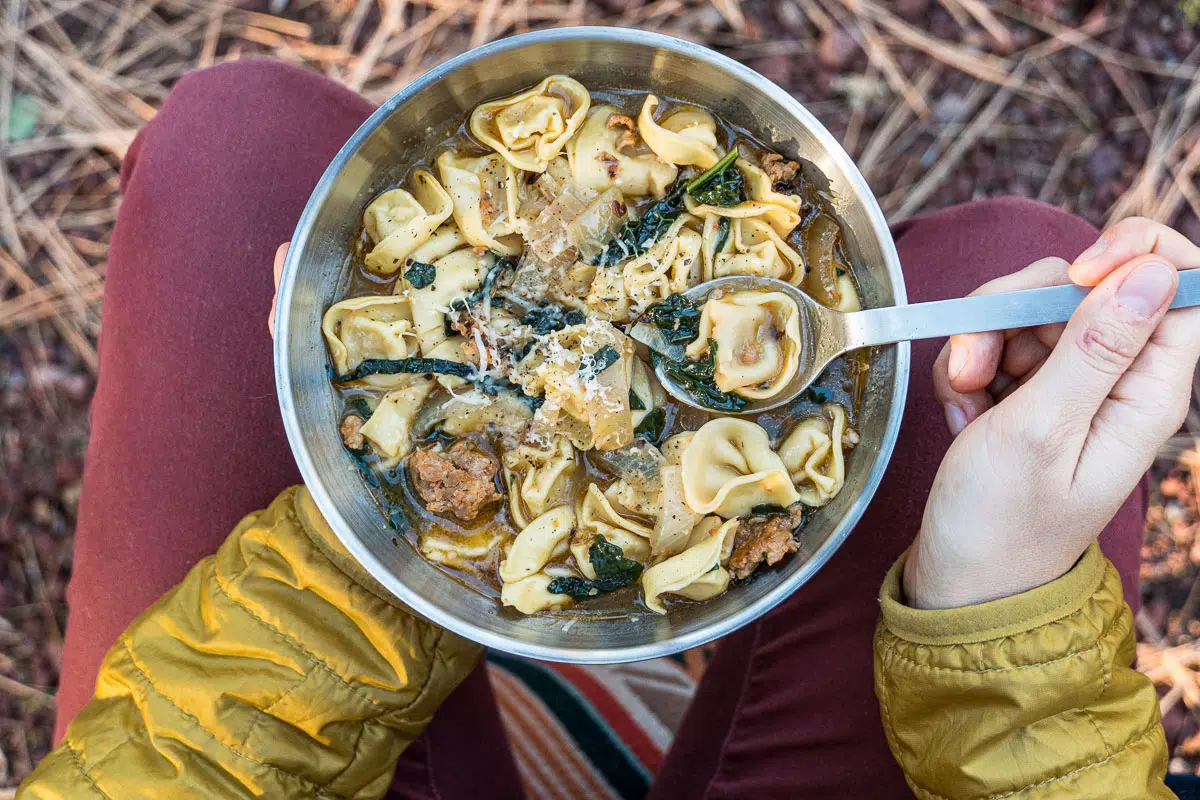
Fall camping meal ideas
Looking for some new recipes to try out this fall? Here are some of our favorite autumn classics!
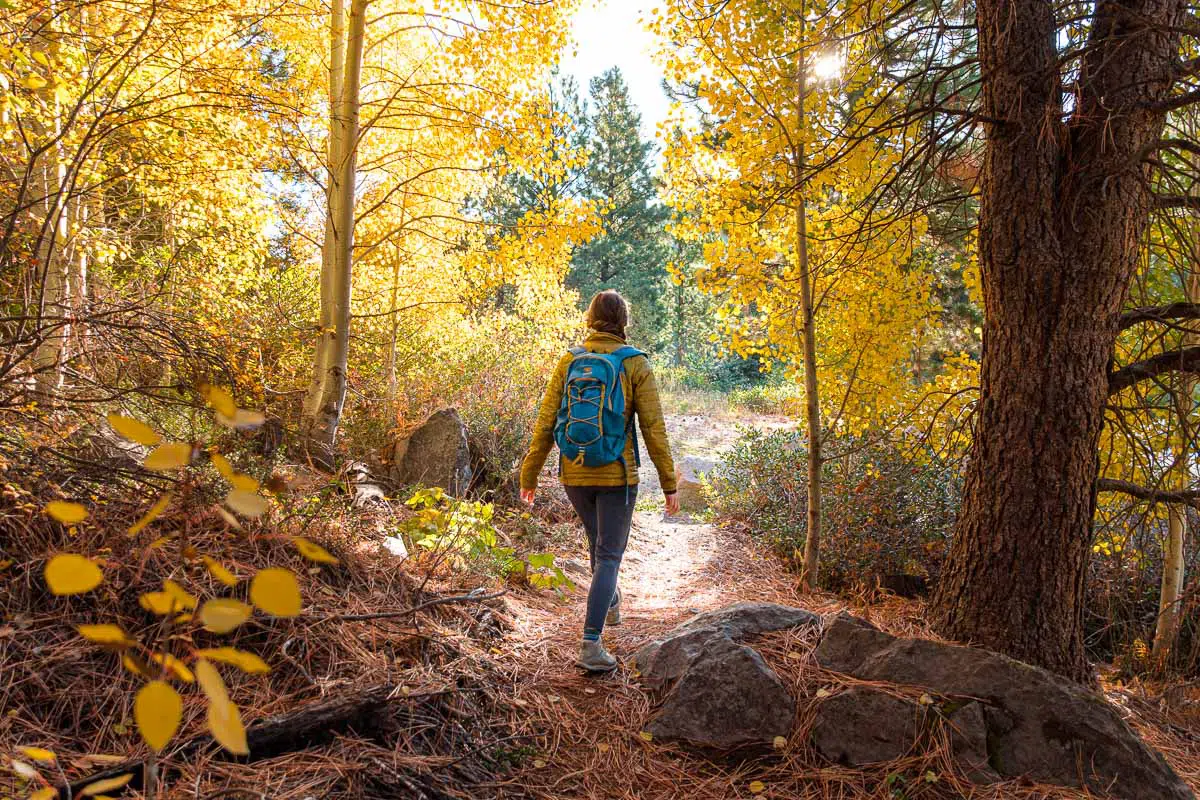
Fall camping activities
- Hiking—use an app like AllTrails to find hiking trails near your campsite. Make sure to pack the 10 hiking essentials if you’re planning to hit the trail, and check out these fall hiking tips.
- Bike riding—as long as the trails are dry, fall is a great time to try mountain biking, or just enjoy a leisurely ride around the campsite.
- Kayaking or canoeing—a great way to go leaf-peeping, in our opinion!
- Build a Swedish Fire Log
- Learn how to cook in a Dutch oven and then try out one of these Dutch oven recipes.
- Go apple picking if there is an orchard nearby. Then make dessert with your haul. Try out our Dutch oven apple cobbler and easy camp apple crisp recipes!
- Keep active, stay warm. Activities that involve movement are great for hanging out at the campsite. Frisbee, bocce ball, spike ball, slacklining.
- Extend your evenings with Tent Time: It’s going to get dark before you’re ready to go to bed. So make sure you have some activities that you can do in the tent. Read a book, play cards, journal, or tell stories. Just because you’re in your sleeping bag doesn’t mean you have to go to sleep right away!
Safety tips
- Check and double-check the weather
- Stay hydrated: It can be easy to forget to drink enough water when you’re outdoors in the fall since the weather might not be giving you that constant nudge to sip throughout the day. But, it’s just as important as ever to stay hydrated as it actually helps your body stay warmer!
- Stay dry: Getting wet (or even damp) when it’s cold or windy out can quickly turn from uncomfortable to dangerous as it zaps your internal body temperature. Stay dry by packing appropriate gear, and if you do get wet, change into dry clothes as quickly as possible.
- Bring backups of key clothing items: warm jacket, socks, shoes, hat, mittens
- Know the signs of hypothermia.
- Have a bailout plan. If it’s just too cold or wet, consider eating dinner at a local restaurant to warm up, or get a hotel or cabin nearby. Worse comes to worse, pack up and head home if it’s not too late and you’re within driving distance. If you’re not having any fun, there’s no reason to suffer through the weekend!
